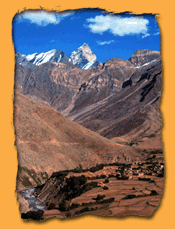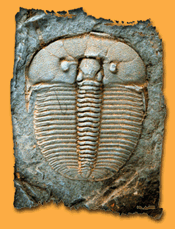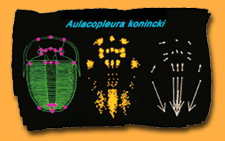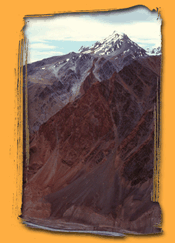Research in Nigel Hughes's lab uses information on fossil morphology to address a variety of evolutionary and geological questions. We are interested in how to use fossil shape to tell us neat things about the evolutionary process and about interesting episodes in Earth's history. We run a wide range, from lab-based and literature-based work through to trotting around at 16,500 ft in the Himalaya. So, if you're into exploring interesting questions with invertebrate fossils this might be the place for you! Here are a couple of examples of current research activitiy:
- Aftermath of the Cambrian Radiation
- Evolution of the Trilobite Body Plan
The Cambrian Radiation
540 million years ago, at the base of the Cambrian time period, there was an explosive diversification in the variety and abundance of animals living in the Earth's oceans. This "Cambrian explosion" is one of the most exciting areas in paleontology, and has been the subject of much public attention. Some of the interest is the result of the discovery and redescription of exceptionally preserved "Burgess Shale-type" faunas, where the soft parts of animals are preserved along with their hard skeletons. While we have learned a tremendous amount from these unique windows of preservation, the exceptional nature of these deposits prevents us from examining the diversification of the soft-bodied fossil groups in detail, because we only see such fleeting glimpses of their evolutionary histories. This is where the "traditional" macrofossil record comes in. Trilobites have a special advantage in this regard because their resistant hard skeletons present us with a quality fossil record throughout most of Paleozoic time. This abundance of trilobite fossils allows us dissect their evolutionary history in detail.
Why Trilobites?
Trilobites are by far the most abundant of all skeletonized Cambrian metazoans. This fact reflects the volumetric and taxonomic abundance of trilobites in a wide range of Cambrian sediments, their intricate and labile morphology, and their occurrence throughout the majority of Cambrian time. These attributes have given the group unrivaled utility as zonal fossils in Cambrian strata, and as the principal faunal element used in Cambrian paleobiogeography. Paradoxically, while trilobites serve as the timekeepers by which we gauge the evolution of other Cambrian metazoans, many aspects of the evolutionary radiation of trilobites remains poorly resolved.
Genes or Ecology?
One of the abiding problems of the Cambrian explosion is to explain how such diversity was generated so quickly. Some have argued that the diversity was generated by "sloppy genes" in these primitive animals, which allowed an unparalleled riot of forms to appear in a short period of geological time. Others suggest that the diversification is a natural consequence of the empty ecological space available in the Cambrian. Because niches were previously unoccupied organisms were able to adapt quickly to exploit these new opportunities without having to out-compete incumbents. Research in our lab is testing these alternatives using a high-resolution field-based approach. It has long been noted that Cambrian trilobites show considerable variation in their patterns of trunk segmentation when compared to the stability exhibited by most post-Cambrian trilobites. Recent studies in developmental biology indicate steriotyped patterns of segmentation and tagmosis among extant arthropods, so that temporal variability in segmentation patterns is likely to signify an important control on trilobite evolution. How did trilobite body patterning change during the evolutionary history of the group? Recent advances in the developmental genetics of extant arthropods are giving us a context in which to review the basic controls of trilobite growth. We are particularly interested in the evolution of the trilobite pygidium - the caudal plate comrised of numerous fused trunk segments. Different trilobite clades repeatedly evolved pygia with morphologies clearly distinctly different from the preceeding thoracic segments, despite a common site of origin near the posterior of the trunk. By dissecting the different aspects of trunk segment size, shape and articulation pattern we are exploring how the trilobites "tagmatized" their rear ends both ontogenetically and phylgenetically.
Our Current Research
Recearch in our lab is focusing on the patterns of variation at low taxonomic levels in the earliest trilobites, the olenellids, and on the evolution of segmentation patterns within the Trilobita. One interesting observation is that fact that thoracic segmentation patterns are noticably more variable in phylogenetically basal trilobites than in more derived taxa. Could this represent the "poorly canalized" developmental control in early trilobites? Our research suggests that this is unlikely - because it seems that advanced forms that secondarily converged on primitive morphotypes mimick a primitive pattern of variation. We are now interested, along with colleagues Alessandro Minelli and Giuseppe Fusco of the University of Padova, in exploring the controls of ontogenetic transitions during trilobite ontogeny. We are finding unexpected complexity in the controls of trilobite segmentation, offering the promise of a new approach toward understanding trilobite developmental biology. Hence there does not appear to be an inviolable developmental constraint that evolved during the history of the group. There are many exciting directions in which this work can progress, linking the areas of paleontology and developmental biology.
The Himalayan Scene
During the Cambrian Gondwanaland coalesced from continental fragments that dispersed after the terminal Proterozoic breakup of the supercontinent Rodinia. Details of Gondwanan accretion are poorly constrained in the equatorial sector of Gondwanaland, where numerous "outboard" microcontinents jostled about the inner Gondwanan "core". Our Himalayan project currently focuses on Cambrian rocks in the Tethyan Himalaya of northern India and Tibet, which represent the equatorial seaward margin of core Gondwanaland at the time. It is a collaborative integrated stratigraphic, paleontologic, and sedimentologic analysis of the trilobite-bearing Cambrian deposits in this region. These deposits are currently poorly known, despite their being volumetrically the most abundant Paleozoic sedimentary rocks preserved in the Himalaya. An integrated stratigraphic analysis of these deposits offers the potential for significant insight into regional paleogeographic relationships during this critical interval of Earth history.
What We're About
The first regional biostratigraphic framework for the Himalayan Cambrian was published by Nigel Hughes and Peter Jell in 1997. This publication has set the stage for this field-based study of sections along the strike of the Himalaya that will: (1) establish an integrated model of the regional paleogeography and margin development during trilobite-bearing Cambrian time; (2) determine the extent to which biofacies models explain trilobite faunal differences within the Himalayan region; (3) constrain the timing and nature of an important but poorly understood late Cambrian orogenic event in the Himalayan region; and (4) assess the paleobiogeographic affinities of the Himalaya with other parts of "core" Gondwanaland, and with "outboard" peri-Gondwanan continental fragments, such as the South China block.
At a broad scale, the Tethyan Himalaya records passive margin deposition in the Early to Middle Cambrian, followed by an orogenic episode sometime in the later Cambrian/early Ordovician. Our present work (With sedimentologist Paul Myrow, Colorado College) seeks to provide chronostratigraphic constraint to help resolve the nature of this event and others that took place along the Indian margin during continental assembly. Of particular interest are the faunal and stratigraphic relationships with the South China block, and the question of the possible microcontinental accretion to the Himalayan margin in the later Cambrian/early Ordovician. In addition to refining our knowledge of the early history of Gondwanaland, the project is also important because geodynamic models of recent Himalayan evolution are in part dependent upon pre-Mesozoic tectono-sedimentary reconstructions.
Our Collaborators
A key aspect of this study is that it is a close collaboration with paleontologists from India (Dr. S.K. Parcha, Wadia Institute of Himalayan Geology, Dr O.N. Bhargava, Chandigarh) and China (Dr. Shanchi Peng, Academia Sinica, Nanjing), who both have extensive field experience in the field areas. We really like the idea of getting good collaborative ventures going with local geologists because of the mutual benefits it provides to all concerned. It also makes it more fun!
Aims for Graduate Students
We want you to leave Riverside having worked hard, completed a good piece of publishable research, and be in an excellent postion to further your career in geology/paleobiology, or in whatever alternative direction you choose. Accordingly, we encourage students to develop research programs that have implications beyond the scope of their dataset or field area. We also put a stress on active graduate student involvement in seminars both within Earth Sciences and, increasingly, as part of the Evolution and Ecology Graduate Research Group, and at making presentations at regional and national meetings. This is because training in the communication of science is of vital importance to your future career. We are pleased with our success - recent graduate students have obtained faculty positions at prestigious institutions such as the University of Chicago, UCLA, Cincinnati Museum Center, and Pomona College.





